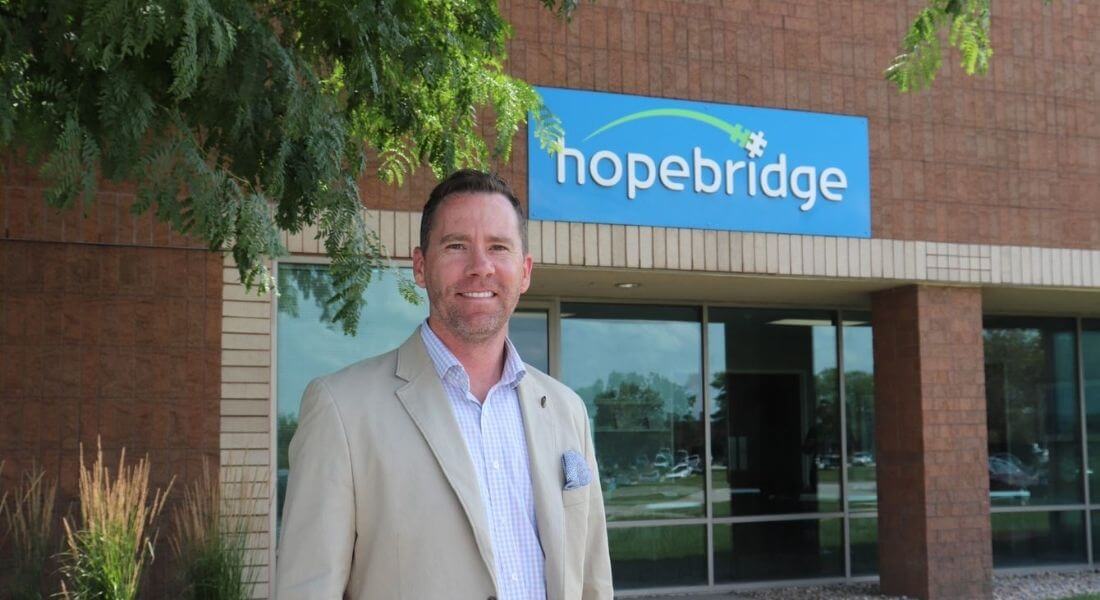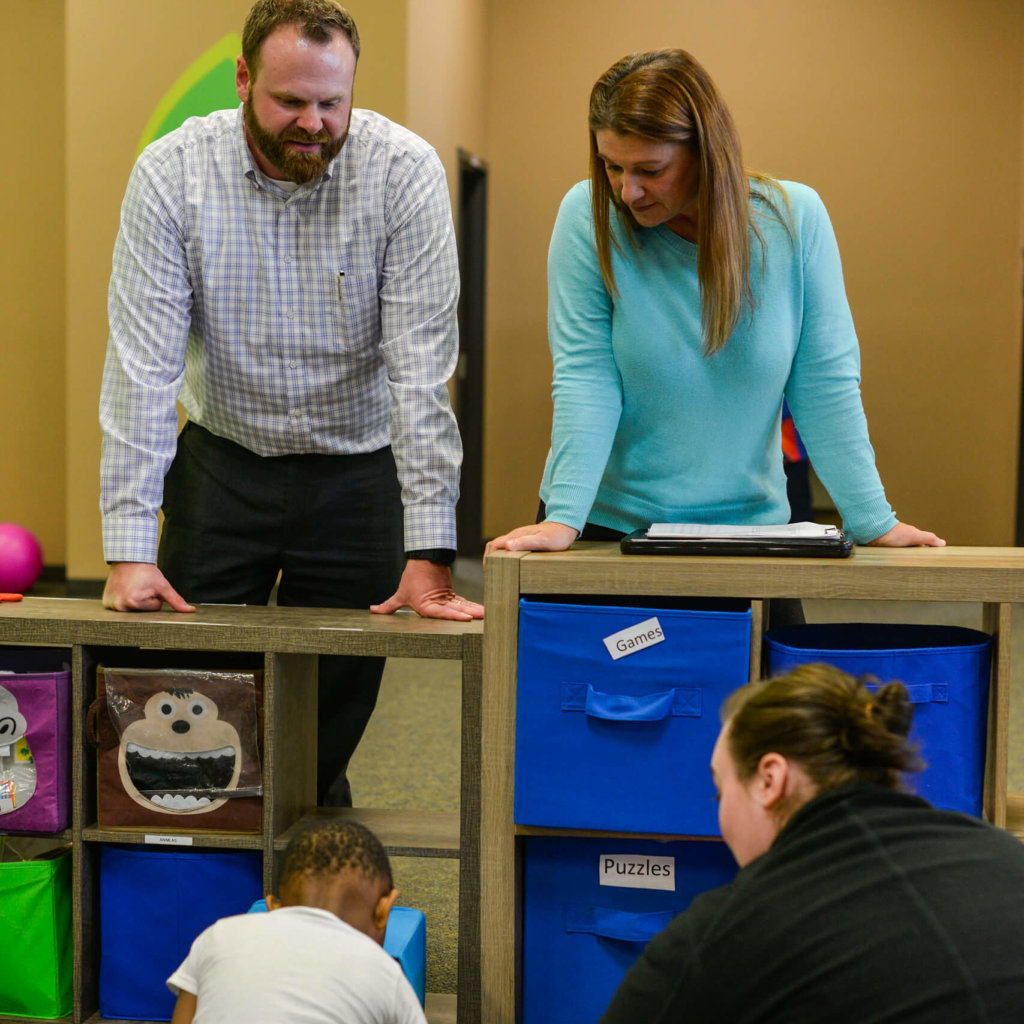Hopebridge Behavior Analysts Receive Exclusive PEAK Training from Dr. Adam Hahs
September 15, 2021
September 15, 2021

Oftentimes, the process of learning something new can be just as significant – if not more so – than learning that specific information or skill. When it comes to children with autism spectrum disorder (ASD) and developmental delays, the process becomes all the more important. Neurodivergent individuals do not necessarily learn in the same ways as their neurotypical peers, and what works for one child may not work for another.
Because of this, at Hopebridge Autism Therapy Centers, it is imperative that we provide opportunities for our clinicians to continuously add to their toolboxes. By expanding their own repertoire of skills and methods, our Hopebridge Heroes are better equipped to provide life-changing care for their kiddos, no matter their abilities and needs.
Most recently, our effort to broaden the knowledge and skill sets of our Board Certified Behavior Analysts (BCBA) includes providing exclusive access to PEAK training from our own resident expert, Hopebridge Chief Science Officer Adam D. Hahs, Ph.D., BCBA-D.
Training for this contemporary, evidence-based learning curriculum is unique to Hopebridge. By training 250 BCBAs, this is the largest rollout of PEAK training for any single company.
“I’ve done this training nationally and internationally, and the audience makeup is usually from various companies and locations. This is the first time we’ve been able to conduct training at such a large scale for one company, so it’s pretty exciting to be able to do this with Hopebridge,” said Dr. Hahs, whose mentor, Dr. Mark R. Dixon, created the PEAK Relational Training System.
To understand the value of this training to Hopebridge children and team members, we connected with Dr. Hahs to share a preview of PEAK for behavior analytic industry clinicians, as well as the families we serve.
PEAK stands for Promoting the Emergence of Advanced Knowledge. Getting off the ground in 2014, it is fairly new within the world of applied behavior analysis (ABA therapy) and autism treatment, however its results are already undeniable.
“The logic is to better prepare clinicians with content from which they can program. PEAK gives us a fuller picture of the skills, or the lack thereof, that a child has when they come into our centers,” said Dr. Hahs.
In simple terms, PEAK stresses the importance of concept formation or development—learning how to learn.
To give an example of concept formation, a child may be taught to “tact” or “label” and provide the names of fruits, such as that an apple is called an apple, but what does it really mean to the child? What is more powerful is understanding the concept of a fruit. Now, when asked to name various fruits, they know enough about fruit to list a number of different kinds. This is when the skill is said to be acquired.
The PEAK Relational Training System consists of four modules that each house specific, targeted content. Here is the breakdown of the modules:
You may still be wondering, “… but how is PEAK used in ABA therapy?”
To explain, let’s back up a little.
Traditionally, the idea and philosophy within behavior analysis is that most of what humans learn is a function of direct experience; that a history of reinforcement or punishment moves behavior accordingly. B.F. Skinner, whose profound influence on behavior still impacts the fields of ABA and psychology today, expanded upon this by focusing on the “why” of verbal behavior through what he called “verbal operants.” Rather than what people say, it’s why they say it. While many effective assessments and curricula have come out of this theory, such as the VB-MAPP, the challenge arises when novel verbal behavior can’t be accounted for by the operants posited by Skinner.

Theorists who came after Skinner shared ideas as to how language could come to be within an individual’s repertoire absent direct reinforcement or punishment. The field evolved with these developments around concepts such as stimulus equivalence, followed by RFT. These theories catalyzed the formation of PEAK.
“When it comes to our thinking around verbal behavior and acquisition, I prefer to treat it as a spectrum, rather than buckets. Buckets suggest that we have to form an allegiance with one of these theories, whereas I like to think about it as a continuum and choose which assessment or curriculum is most applicable to each specific patient we serve,” said Dr. Hahs. “When we lead with this, we’ll be more likely to develop treatment plans without bias.”
“Only under certain circumstances might I invoke some of the more complex analysis of verbal behavior in relational frame theory. When the patient has a strong foundation of verbal behavior as evidenced through a robust verbal operant repertoire, then I might integrate stimulus equivalence and relational frame theory.”
The most obvious benefit of this training is that it trickles down to provide more opportunities for more children to learn new skills. The lift the patient gets is what gives PEAK the “wow” factor.
Through stimulus equivalence and derived relational responding, children now experience the emergence of skills without direct training, which couldn’t be accounted for through historic thinking around how people learn. When analyses have been conducted about individuals’ repertoires using assessment and curricula that are driven by Skinner’s theory, such as through the VB-MAPP, there can be gaps. To give an idea of the broadened scope PEAK offers, the VB-MAPP targets approximately 170 skills, whereas each individual module within PEAK covers 184 skills.
“If our clinicians aren’t well equipped to program for certain skills that are absent, PEAK provides a roadmap for filling those voids through more robust analysis and programming opportunities. Before PEAK came along, we may not have been able to fill those gaps in skills for some children who learn in a different way.”
For example, earlier in Dr. Hahs’ tenure as a BCBA, he worked with a young girl diagnosed with ASD, Down Syndrome and cerebral palsy, who was significantly impacted by intellectual and physical challenges. Though PEAK was not in existence at the time, he used what was, in essence, a stimulus equivalence paradigm to teach her numbers.
Originally, he and his team attempted to teach directly to the counting of numbers—see a number and vocally count “1, 2, 3, 4, 5 …” However, a challenge arose with regression of the skill. When and only when they taught directly, the skill would emerge, but it would not maintain.

To overcome this, they began to teach her that the actual numerical number (such as “5”), was equal to that specific number of dots. They worked with her to choose a card with a certain number of dots when she saw the matching card featuring it written numerically. Next, they introduced an auditory device that was programmed to count aloud when it was tapped. If they presented five dots, she would tap it five times.
Typical behavior analytic programming would suggest that Dr. Hahs then needed to program the numerical “5” to the actual pressing of the button. However, stimulus equivalence works on the premise of logic, so they were able to skip this step. When he presented the number and gave her the device, she could type it out, even without direct training.
“That was the ‘aha’ moment of stimulus equivalence. You learn that you do not need to train everything that falls within a stimulus class,” said Dr. Hahs. “The best part is getting to see it in action. When you watch a kid hit that light switch to something they haven’t been taught, it’s incredible, but it works because of how we learn, not because it’s magic.”
On top of seeing the gains in action, PEAK training benefits BCBAs in that it creates better economy of instruction. In Dr. Hahs’ example, he needed to teach only two relationships; essentially gaining four for “free.” By applying these concepts, it is no longer necessary for behavior analysts to directly train each one. From a programmatic standpoint, therapy can become more efficient.
“PEAK training with Dr. Hahs was both informative and entertaining. I learned new methods to facilitate client learning and skill acquisition. Dr. Hahs piqued my interest in this curriculum method and has left me interested in learning more about it,” said Hopebridge BCBA Enrique Leon from our autism therapy center in Westminster, Colorado.

PEAK training provides Hopebridge employees with benefits in the professional development arena, too, of course. Through this training, BCBAs receive the opportunity to contact content that they would otherwise need to piecemeal together, unless they choose to attend a training on their own – with a cost north of $400.
“Hopebridge is creating a hub for internal growth in the domain of PEAK so as to better serve our patient population,” said Dr. Hahs. “Whether or not we adopt it, PEAK will continue to become more relevant. This training allows Hopebridge and our clinicians to stay on the cutting edge of science and practice in this field of ABA.”
“This training provided clear examples and instructions with videos on how to program within the curriculum, and I am excited to put this into clinical practice as another tool in my toolbox to better support our patients’ learning,” said Hopebridge BCBA Katie Rodio, who works at our center in Aurora, Colorado. “Using this curriculum has helped move from a conceptual understanding of relational theory to implementing it within the applied setting at Hopebridge.”
Beyond the ability to take part in something revolutionary in the world of ABA – at no cost to our BCBAs – 10 free CEUs is an added perk of the training.
Does hearing about this type of training and experience get you even more excited about working with children with autism? We want to open a world of possibilities for you and our kiddos with professional development and education opportunities like this.
If growing from within a company intrigues you, we hope you’ll consider joining our team of Hopebridge Heroes. Check out our open positions in autism therapy centers across the nation to help us make a difference in these families’ lives—and your own.
*Informed consent was obtained from the participants in this article. This information should not be captured and reused without express permission from Hopebridge, LLC. Testimonials are solicited as part of an open casting call process for testimonials from former client caregivers. Hopebridge does not permit clinical employees to solicit or use testimonials about therapeutic services received from current clients (Ethics Code for Behavior Analysts 5.07-5.08; BACB, 2020). Hopebridge does not provide any incentives, compensation, or renumeration for testimonials provided by a former client or client caregiver.
Autism Therapy
October 21, 2020
RBT Study Guide: The Best Resources to Become a Registered Behavior Technician